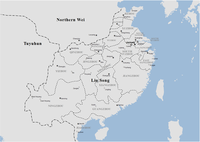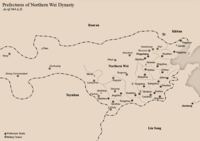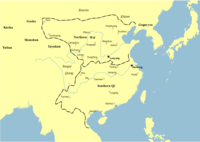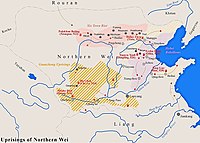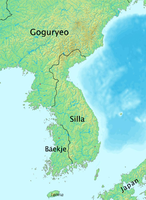Timeline of the Northern and Southern dynasties
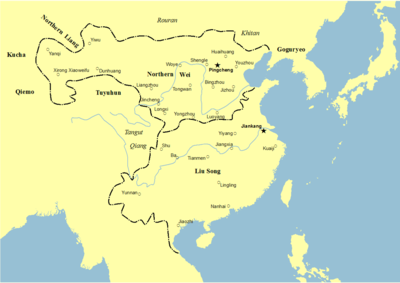
This is a timeline of the Northern and Southern dynasties in China.
380s
[edit]| Year | Date | Event |
|---|---|---|
| 386 | Northern Wei: Tuoba Gui revives the Tuoba state[1] | |
| Later Qin: Yao Chang declares himself emperor[1] | ||
| 387 | Later Liang: Lü Guang declares himself Duke of Jiuquan[1] |
390s
[edit]| Year | Date | Event |
|---|---|---|
| 393 | Wei: Conquered by Later Yan[2] | |
| 394 | Later Qin: Conquers Former Qin[1] | |
| Later Yan: Conquers Western Yan[1] | ||
| 395 | Northern Wei: Tuoba Gui defeats Later Yan at Canhepi (east-northeast of Liangcheng, Inner Mongolia)[1] | |
| 396 | Northern Wei: Tuoba Gui takes Bingzhou from Later Yan[1] | |
| Emperor Xiaowu of Jin dies and is succeeded by Sima Dezong (Emperor An of Jin)[1] | ||
| 397 | Southern Liang: Tufa Wugu declares himself Prince of Xiping[1] | |
| Northern Liang: Duan Ye declares himself Duke of Jiankang in Zhangye[1] | ||
| 398 | Northern Wei: Tuoba Gui moves his capital to Pingcheng[1] | |
| 399 | Northern Wei: Tuoba Gui declares himself emperor[1] | |
| Sun En revolts[1] | ||
| Faxian leaves for India[1] |
400s
[edit]| Year | Date | Event |
|---|---|---|
| 400 | Western Liang (Sixteen Kingdoms): Li Gao declares himself Duke of Liang in Dunhuang[1] | |
| Western Qin: Submits to Southern Liang and then Later Qin[3] | ||
| Southern Yan: Murong De declares himself emperor in Guanggu[4] | ||
| 401 | Northern Liang: Juqu Mengxun kills Duan Ye and declares himself Duke of Zhangye[4] | |
| 402 | Huan Xuan sacks Jiankang and Sun En dies, but his lieutenant Lu Xun takes over[4] | |
| 403 | Later Liang: Surrenders to Later Qin[4] | |
| 404 | Huan Xuan declares himself emperor and dies the same year[4] | |
| 405 | Qiao Zong declares himself Prince of Chengdu[4] | |
| 407 | Xia: Helian Bobo declares himself Heavenly King[4] | |
| Northern Yan: Gao Yun is set up as heavenly king and replaces Later Yan[4] | ||
| 409 | Western Qin: Revived[3] |
410s
[edit]| Year | Date | Event |
|---|---|---|
| 410 | Liu Yu conquers Southern Yan[4] | |
| 411 | Rebel Lu Xun dies[4] | |
| 412 | Faxian returns from India[4] | |
| 413 | Jin recovers Sichuan and Qiao Zong commits suicide[4] | |
| 414 | Western Qin: Conquers Southern Liang[4] | |
| 416 | Jin takes Luoyang from Later Qin[4] | |
| Huiyuan dies[4] | ||
| 417 | Jin conquers Later Qin and Liu Yu takes Chang'an[4] | |
| 418 | Jin troops retreat from Chang'an[4] | |
| Xia (Sixteen Kingdoms): Helian Bobo takes Chang'an[4] | ||
| 419 | Xia (Sixteen Kingdoms): Helian Bobo leaves Chang'an[4] |
420s
[edit]| Year | Date | Event |
|---|---|---|
| 420 | Liu Yu (Emperor Wu of Liu Song) replaces the Jin dynasty with the Song dynasty[5] | |
| 421 | Northern Liang: Juqu Mengxun conquers Western Liang (Sixteen Kingdoms)[6] | |
| 422 | Emperor Wu of Liu Song dies and is succeeded by Liu Yifu, Emperor Shao of Liu Song[5] | |
| 423 | Kou Qianzhi sets up the Celestial Master at Pingcheng[5] | |
| 424 | Emperor Shao of Liu Song is deposed and succeeded by Liu Yilong (Emperor Wen of Liu Song)[5] | |
| 426 | Northern Wei: Attacks Xia[5] | |
| 427 | Northern Wei: Takes Chang'an and sacks the Xia capital, Tongwan[5] | |
| 428 | Xia: Retakes Chang'an[5] |
430s
[edit]| Year | Date | Event |
|---|---|---|
| 430 | Northern Wei: Takes Luoyang from Liu Song | |
| Western Qin: Abandons Yuanchuan and Fuhan to the Tuyuhun and relocates to Pingliang and Anding[5] | ||
| 431 | Xia: Conquers Western Qin and are in turn conquered by the Tuyuhun[5] | |
| 433 | Xie Lingyun is killed[5] | |
| 434 | Northern Wei: Enters a marriage alliance with the Rouran[5] | |
| Song retakes Hanzhong from Chouchi[5] | ||
| 435 | Northern Wei: Attacks Northern Yan[5] | |
| 436 | Northern Wei: Conquers Northern Yan, whose sovereign Feng Hong flees to Goguryeo[5] | |
| 439 | Northern Wei: Conquers Northern Liang; so ends the Sixteen Kingdoms[5] |
440s
[edit]| Year | Date | Event |
|---|---|---|
| 442 | Northern Wei: Tuoba Tao takes part in a Daoist ritual to receive talisman registers[7] | |
| 445 | Northern Wei: Ge Wu rebels in Guanzhong[7] | |
| 446 | Northern Wei: Ge Wu dies[7] | |
| Northern Wei: Cui Hao instigates proscription campaigns against Buddhism[7] | ||
| 449 | Northern Wei: Defeats the Rouran in battle[7] |
450s
[edit]| Year | Date | Event |
|---|---|---|
| 450 | Northern Wei: Cui Hao is killed[7] | |
| Liu Song launches a campaign against Northern Wei[7] | ||
| 451 | Northern Wei: Tuoba Tao leads his army south to Guabu (southeast of Luhe, Jiangsu)[7] | |
| Pei Songzhi dies[7] | ||
| 453 | Emperor Wen of Liu Song is killed by Liu Shao, who is killed Liu Jun (Emperor Xiaowu of Liu Song)[7] | |
| Northern Wei: Construction of the Yungang Caves begin[7] | ||
| 458 | Liu Song launches a campaign against Buddhism[7] |
460s
[edit]| Year | Date | Event |
|---|---|---|
| 464 | Emperor Xiaowu of Liu Song dies and is succeeded by Liu Ziye (Emperor Qianfei of Liu Song)[7] | |
| 465 | Northern Wei: Emperor Wencheng of Northern Wei dies and is succeeded by Tuaba Hong (Emperor Xianwen of Northern Wei)[7] | |
| Emperor Qianfei of Liu Song dies[7] | ||
| 466 | Liu Yu (Emperor Ming of Liu Song) takes power[7] | |
| Bao Zhao is killed[7] | ||
| 467 | Northern Wei: Conquers territory north and west of the Huai River[7] | |
| 469 | Northern Wei: Takes Qingzhou and Jizhou (冀州) (north Jiangsu)[7] |
470s
[edit]| Year | Date | Event |
|---|---|---|
| 471 | Northern Wei: Emperor Xianwen of Northern Wei abdicates in favor of Yuan Hong (Emperor Xiaowen of Northern Wei)[7] | |
| 472 | Emperor Ming of Liu Song dies and is succeeded by Liu Yu (Emperor Houfei of Liu Song)[8] | |
| 477 | Emperor Houfei of Liu Song is killed by Xiao Daocheng and is succeeded by Liu Zhun (Emperor Shun of Liu Song)[8] | |
| 479 | Xiao Daocheng (Emperor Gao of Southern Qi) replaces Liu Song with the Southern Qi[8] |
480s
[edit]| Year | Date | Event |
|---|---|---|
| 482 | Emperor Gao of Southern Qi dies and is succeeded by Xiao Ze (Emperor Wu of Southern Qi)[8] | |
| 485 | Northern Wei: The equal-field system is implemented[8] | |
| 486 | Northern Wei: The Three Chiefs system is implemented[8] |
490s
[edit]| Year | Date | Event |
|---|---|---|
| 493 | Emperor Wu of Southern Qi dies and is succeeded by Xiao Zhaoye[8] | |
| Northern Wei: Li Chong starts constructions in Luoyang[8] | ||
| 494 | Northern Wei: Emperor Xiaowen of Northern Wei moves to Luoyang[8] | |
| Northern Wei: Construction on the Longmen Caves begin[8] | ||
| 495 | Northern Wei: Emperor Xiaowen of Northern Wei bans Xianbei language in court[8] | |
| 498 | Emperor Ming of Southern Qi dies and is succeeded by Xiao Baojuan[8] | |
| 499 | Northern Wei: Emperor Xiaowen of Northern Wei dies and is succeeded by Yuan Ke (Emperor Xuanwu of Northern Wei)[8] |
500s
[edit]| Year | Date | Event |
|---|---|---|
| 500 | Northern Wei: Conquers territory south of the Huai River[8] | |
| 501 | Emperor He of Southern Qi is enthroned in Jiangling as a rival to Xiao Baojuan[8] | |
| 502 | Xiao Baojuan is killed in Jiankang and Xiao Yan kills Emperor He of Southern Qi, founding his own Liang dynasty[8] | |
| 504 | Northern Wei: Conquers Yiyang[8] | |
| 506 | Northern Wei: Annexes Chouchi[9] | |
| 507 | Northern Wei: Is defeated by Liang dynasty at Zhongli (northeast of Fengyang, Anhui)[8] |
510s
[edit]| Year | Date | Event |
|---|---|---|
| 512 | Northern Wei: Loses Qushan (southwest of Lianyungang, Jiangsu) to Liang dynasty[10] | |
| 518 | Northern Wei: Song Yun departs for the Western Regions[10] |
520s
[edit]| Year | Date | Event |
|---|---|---|
| 520 | Northern Wei: Yujiulü Anagui takes shelter[10] | |
| 522 | Northern Wei: Song Yun returns from India with 170 Buddhist sutras[10] | |
| 523 | Northern Wei: The Six Frontier Towns rebel under Poliuhan Baling[10] | |
| 525 | Northern Wei: Yujiulü Anagui defeats Poliuhan Baling[10] | |
| Northern Wei: Du Luozhou rebels in north Hebei[10] | ||
| 526 | Northern Wei: Ge Rong rebels in north Hebei[10] | |
| 527 | Northern Wei: Xiao Baoyin rebels in Guanzhong and kills Li Daoyuan[10] | |
| 528 | Northern Wei: Erzhu Rong kills Yuan Zhao and enthrones Yuan Ziyou (Emperor Xiaozhuang of Northern Wei)[10] | |
| Northern Wei: Ge Rong is defeated[10] | ||
| 529 | Emperor Wu of Liang enters the Tongtai Monastery[10] |
530s
[edit]| Year | Date | Event |
|---|---|---|
| 530 | Northern Wei: Emperor Xiaozhuang of Northern Wei kills Erzhu Rong but is killed by Erzhu Zhao[10] | |
| 532 | Northern Wei: Gao Huan enthrones Yuan Xiu (Emperor Xiaowu of Northern Wei)[10] | |
| 533 | Northern Wei: Erzhu Zhao kills himself[10] | |
| 534 | Northern Wei: Emperor Xiaowu of Northern Wei escapes to Chang'an[10] | |
| Eastern Wei: Gao Huan sets up Yuan Shanjian as Emperor Xiaojing of Eastern Wei[10] | ||
| 535 | Western Wei: Yuwen Tai kills Emperor Xiaowu of Northern Wei and enthrones Yuan Baoju (Emperor Wen of Western Wei)[11] | |
| 536 | Tao Hongjing dies[11] | |
| Eastern Wei: Chan Buddhism founder Bodhidharma dies[11] | ||
| 537 | Battle of Shayuan: Yuwen Tai defeats Gao Huan[11] |
540s
[edit]| Year | Date | Event |
|---|---|---|
| 541 | Lý Bôn rebels and attacks Liang officials[12] | |
| 543 | Eastern Wei: Gao Huan defeats Yuwen Tai at Luoyang[11] | |
| 544 | Lý Bôn establishes the Early Lý dynasty and becomes Lý Nam Đế (Southern Emperor)[12] | |
| 545 | Chen Baxian drives Lý Nam Đế into the mountains, where he is eventually killed, but resistance continues under Lý Thiên Bảo[12] | |
| 547 | Eastern Wei: Gao Huan dies and Hou Jing defects to Liang dynasty[11] | |
| 548 | Hou Jing rebels in Shouyang and lays siege to Jiankang[11] | |
| 549 | Hou Jing seizes Taicheng[11] | |
| Emperor Wu of Liang dies and is succeeded by Xiao Gang (Emperor Jianwen of Liang)[11] | ||
| Xiao Cha defects to Western Wei[11] | ||
| Eastern Wei: Conquers area south of the Huai River[11] |
550s
[edit]| Year | Date | Event |
|---|---|---|
| 550 | Western Wei: Conquers area east of the Han River (Hubei)[11] | |
| Northern Qi: Gao Yang (Emperor Wenxuan of Northern Qi) replaces Eastern Wei with Northern Qi and conquers areas east of Luoyang[11] | ||
| The fubing system is introduced[11] | ||
| 551 | Hou Jing kills Emperor Jianwen of Liang and declares himself emperor[11] | |
| 552 | Wang Sengbian and Chen Baxian take Jiankang[13] | |
| Hou Jing is killed[13] | ||
| Xiao Ji declares himself emperor in Jiangling[13] | ||
| 553 | Xiao Ji is killed by Emperor Yuan of Liang's generals[13] | |
| Western Wei: Conquers Sichuan[13] | ||
| Northern Qi: Rouran submit after behind being defeated by Turks[13] | ||
| 554 | Emperor Yuan of Liang is captured by Western Wei and killed[13] | |
| 555 | Western Liang: Xiao Cha declares himself emperor in Jiangling[13] | |
| Wang Sengbian sets up Xiao Yuanming but Chen Baxian kills Sengbian and sets up Xiao Fangzhi (Emperor Jing of Liang)[13] | ||
| 556 | Northern Qi: Attack on Jiankang fails[13] | |
| Western Wei: Yuwen Tai dies[13] | ||
| 557 | Northern Zhou: Yuwen Hu replaces Western Wei with Northern Zhou[13] | |
| Chen Baxian replaces the Liang dynasty with the Chen dynasty[13] | ||
| 558 | Western Liang: Takes Changsha and Wuling[13] | |
| 559 | Chen Baxian dies and is succeeded by Chen Qian (Emperor Wen of Chen)[13] |
560s
[edit]| Year | Date | Event |
|---|---|---|
| 560 | Northern Zhou: Yuwen Hu kills Emperor Ming of Northern Zhou and sets up Yuwen Yong (Emperor Wu of Northern Zhou)[13] | |
| Northern Qi: Gao Yan (Emperor Xiaozhao of Northern Qi) ousts Emperor Fei of Northern Qi and sets himself up as emperor[13] | ||
| 561 | Northern Zhou: North Hubei is lost to the Chen dynasty[13] | |
| Northern Qi: Emperor Xiaozhao of Northern Qi dies and is succeeded by Gao Zhan (Emperor Wucheng of Northern Qi)[13] | ||
| 565 | Northern Qi: An attack by Northern Zhou is repulsed[14] | |
| Northern Qi: Emperor Wucheng of Northern Qi abdicates to Gao Wei[14] | ||
| 566 | Emperor Wen of Chen dies and is succeeded by Chen Bozong (Emperor Fei of Chen)[14] | |
| 568 | Emperor Fei of Chen is deposed[14] | |
| 569 | Chen Xu (Emperor Xuan of Chen) takes power[14] |
570s
[edit]| Year | Date | Event |
|---|---|---|
| 570 | Chen dynasty establishes trade relations with the Early Lý dynasty[12] | |
| 572 | Northern Zhou: Emperor Wu of Northern Zhou kills Yuwen Hu[14] | |
| 573 | Northern Qi: Loses areas north of the Changjiang to the Chen dynasty, including the Huai River valley[14] | |
| 574 | Northern Zhou: Emperor Wu of Northern Zhou launches proscription against Buddhism[14] | |
| 575 | Northern Qi: Forces are defeated by Chen dynasty at Lüliang[14] | |
| Northern Zhou: Attacks Northern Qi[14] | ||
| 576 | Northern Zhou: Takes Jinyang[14] | |
| 577 | Northern Zhou: Annexes Northern Qi[14] | |
| 578 | Northern Zhou: Repulses a Chen attack on Pengcheng and captures Wu Mingche[14] | |
| Northern Zhou: Emperor Wu of Northern Zhou dies and is succeeded by Yuwen Yun (Emperor Xuan of Northern Zhou)[14] | ||
| 579 | Northern Zhou: Emperor Xuan of Northern Zhou abdicates to Yuwen Chan (Emperor Jing of Northern Zhou)[14] |
580s
[edit]| Year | Date | Event |
|---|---|---|
| 580 | Northern Zhou: Seizes area north of the Changjiang[14] | |
| Northern Zhou: Yang Jian becomes de facto holder of power[14] | ||
| Northern Zhou: Yuchi Jiong and Wang Qian rebel but fail[14] | ||
| 581 | Sui dynasty: Yang Jian (Emperor Wen of Sui) replaces the Northern Zhou with the Sui dynasty[15] | |
| 582 | Emperor Xuan of Chen dies and is succeeded by Chen Shubao[15] | |
| 583 | Sui dynasty: Emperor Wen of Sui moves into Daxingcheng (Xi'an, Shaanxi) and abolishes the commanderies while promulgating the Kaihuang Code[15] | |
| 584 | Sui dynasty: Digs the Guangtong Canal[14] | |
| 587 | Sui dynasty: Annexes Western Liang[15] | |
| 588 | Sui dynasty: Launches expedition against the Chen dynasty[15] | |
| 589 | Sui dynasty: Takes Jiankang and annexes the Chen dynasty; so ends the Northern and Southern dynasties[15] |
Gallery
[edit]- Northern Wei in 464 AD
- Korea in 476 AD
- 497 AD
- Uprisings of Northern Wei (523–528)
- 541 AD
- 562 AD
- 572 AD
- Korea in 576 AD
References
[edit]- ^ a b c d e f g h i j k l m n o Xiong 2009, p. xcvii.
- ^ Xiong 2009, p. 123.
- ^ a b Xiong 2009, p. 547.
- ^ a b c d e f g h i j k l m n o p q r s Xiong 2009, p. xcviii.
- ^ a b c d e f g h i j k l m n o Xiong 2009, p. xcix.
- ^ Xiong 2009, p. 273.
- ^ a b c d e f g h i j k l m n o p q r s t Xiong 2009, p. c.
- ^ a b c d e f g h i j k l m n o p q r Xiong 2009, p. ci.
- ^ Xiong 2009, p. 414.
- ^ a b c d e f g h i j k l m n o p q Xiong 2009, p. cii.
- ^ a b c d e f g h i j k l m n o Xiong 2009, p. ciii.
- ^ a b c d Taylor 2013.
- ^ a b c d e f g h i j k l m n o p q r s Xiong 2009, p. civ.
- ^ a b c d e f g h i j k l m n o p q r s Xiong 2009, p. cv.
- ^ a b c d e f Xiong 2009, p. cvi.
Bibliography
[edit]- Crespigny, Rafe (2007), A Biographical Dictionary of Later Han to the Three Kingdoms (23-220 AD), Brill
- Taylor, K.W. (2013), A History of the Vietnamese, Cambridge University Press
- Xiong, Victor Cunrui (2009), Historical Dictionary of Medieval China, United States of America: Scarecrow Press, Inc., ISBN 978-0810860537


 French
French Deutsch
Deutsch